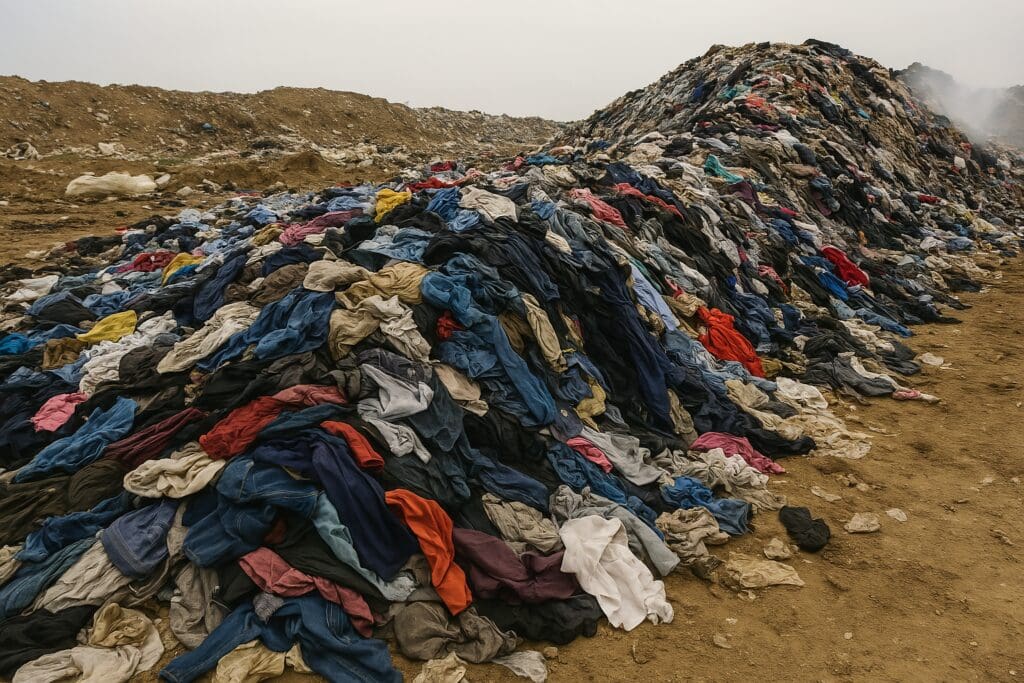Reduce
Learn how reducing consumption can benefit the planet.
Circular Fashion
Circular fashion is a way of designing, making, and using clothes that keeps them in use for as long as possible — and ensures they can be reused, repaired, or recycled instead of ending up in landfill. It’s about moving away from fast fashion’s throwaway culture, and rethinking our relationship with clothing to reduce waste and protect the planet.
We created this short video to explain Fashion’s Waste Problem in more detail
What's the Difference?
Sustainability and circularity are closely connected but distinct. Sustainability aims to balance environmental, social, and economic well-being, while circularity is a key strategy within it, focusing on eliminating waste and keeping materials in use. Circular systems—like recycling, repair, and reuse—reduce resource extraction, lower emissions, and lessen environmental and social harm. Simply put, sustainability is the goal, and circularity is a critical path to achieving it.
The traditional fashion system is designed for disposability—clothes are made quickly, worn briefly, and discarded. This cycle drives overproduction, resource depletion, and environmental harm.
Raw materials are extracted (cotton, polyester, etc.), often with high environmental costs.
Garments are mass-produced, often with little regard for durability or repairability.
Many clothes are worn only a few times before losing value.
Most discarded clothing ends up in landfills or incinerators, with less than 1% recycled into new textiles.
Circular fashion rethinks the entire system, keeping clothing in use for as long as possible and reducing demand for new resources.
Source fibres responsibly, prioritizing regenerative, recycled, or sustainably grown materials that consider the full lifecycle of clothing.
Manufacture textiles with durability, repairability, and recyclability in mind, using processes that minimize environmental impact.
Design and produce garments that are made to last, with quality construction that supports long-term use and easy repair.
Move products through efficient, responsible supply chains that reduce waste and carbon emissions, ensuring better access to durable goods.
Buy less and choose better. Prioritize thoughtful purchases that focus on quality, longevity, and need — not trends or fast fashion.
Take care of your clothes through mindful washing, drying, and storing to keep them in good condition and extend their lifespan.
Swap, thrift, or simply wear what you already own — extending the life of your clothes without producing anything new.
Fix minor damages like tears, missing buttons, and loose seams to keep clothing in use and out of landfill.
Give garments another life by renting, buying, or selling pre-loved clothing through sharing platforms, resale apps, or secondhand shops.
Creatively transform existing garments into new, one-of-a-kind pieces, extending their life through design and imagination.
Recover fibres from old textiles and remake them into new garments — keeping materials circulating within the fashion system.
Break down textiles into materials for other uses, like insulation or padding, keeping resources in use even outside the fashion industry.
Today’s fashion system has significant challenges—it fuels overproduction, waste, and exploitation while depleting resources at an unsustainable rate. But change is happening. Innovation, policy shifts, and growing consumer awareness are driving progress toward a more circular and responsible industry. While it’s crucial to acknowledge the negative impacts, it’s just as important to highlight the solutions, advancements, and collective efforts shaping a better future for fashion.

Extending the life of clothes by just nine extra months of active use would reduce carbon, water and waste footprints by around 20-30% each. (New Standard Institute)
Global sales of pre-owned clothes are forecast to reach $350bn in 2028 (thredup)
We buy 60% more clothes today than 20 years ago and we keep them for half as long!
67% of our clothes contain plastic. Synthetic fibres (polyester, spandex) are plastic and will never biodegrade in a landfill.
Tagline
The 3R Waste Hierarchy—Reduce, Reuse, Recycle—is a key framework for minimizing environmental impact, but the fashion industry requires a more comprehensive approach. That’s where the 7Rs come in, expanding on the traditional model to address the full lifecycle of clothing, from mindful purchasing to responsible disposal.
The 7Rs – Reduce, Reuse, Repair, Repurpose, Resell, Rent, and Recycle – offer practical ways to keep clothing in use longer. Explore each step and discover simple actions to make your wardrobe more circular.
Participate in the 7Rs of Fashion pledge in order to reduce my fashion footprint!